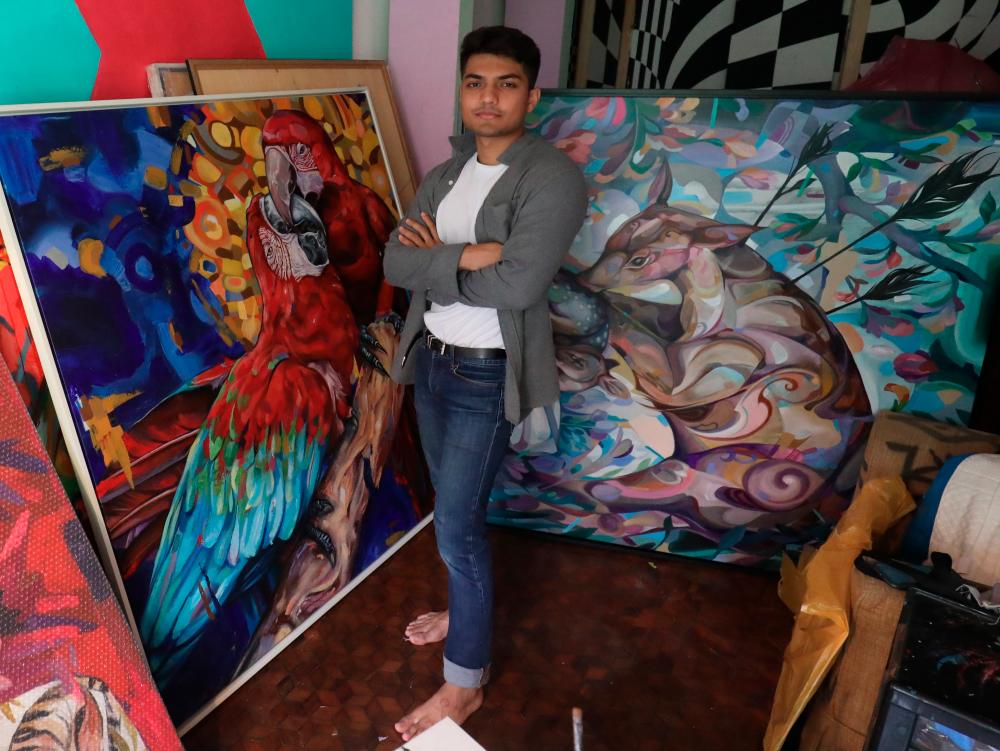SOMEWHERE in Kuala Lumpur, in an apartment surrounded by greenery, sits a young artist in his studio. He is at a table looking down at his latest work, lit by a single lamp hanging from the ceiling and whatever natural light that comes through the window.
Leaning against the wall are lean canvases ranging from the size of a small child to that of a fully grown man. Each of them show beautiful works of acrylic on canvas, colourful and inspired by nature.
This was our first impression of the studio of 27-year-old Haris Rashid, a self-made and accomplished visual artist.
Looking at his masterpieces, one could not have guessed that they were made by an avid outdoorsman with no formal education in fine arts.
When did you start doing art?
“I did my own work since college. I did artwork not realising it is fine arts, I just did it for fun. At first I started by opening booths selling prints and badges at Publika’s art row. Like the Fuyo Art Bazaar.
“It was just for fun. I didn’t make much money and I did that for about three years. I then worked at a desk job for a while, but it didn’t feel right. Working nine-to-five did not feel like the right thing for me. So it only lasted for six months.”
How did you get your first solo show?
“After the desk job, I continued doing the booth thing, hoping that it would be more profitable. By then I already had a body of work [but had] no knowledge of doing solo exhibitions ... I started emailing galleries around KL. I was pretty naive at the time. I thought, maybe, just maybe, that this would work.
“That’s when Artemis Art in Publika said ‘yes’ and gave me a solo show.
“From there my first solo show was with them. Tun Daim [Zainuddin, former Finance Minster], a family friend, opened the show, something that he has never done before and it shocked the art scene.”
How did you start in the art scene?
“I didn’t know getting into the art scene was difficult. I just got in and I just did it.
“I didn’t study fine arts. My work is very illustration-based, and I have a graphics design background. I studied working with digital art, but I didn’t like it. I like to be hands on with the art.
“I started with colour pencils and linework on paper, so my earlier works look like tattoos. A lot of line work and graphic influences.
“After the first show, the gallery suggested that I [work on] canvas, because it is easier to sell. Collectors want more, and it is easier to keep.”
How many artworks have you done?
“In the last five years I have produced a lot of artwork. What I keep in the studio is just the half of it, the other half is at my home. This is not counting the ones I have sold.
“The thing is I produce works quite quickly. So I accumulate a lot. All the big pieces I did for my second solo [exhibition] took me about six months. That’s approximately one piece per week.”
What inspires you?
“I’ve always liked colour and nature. Nature for me is like [something] I always go back to if I am frazzled. It is always square one for me.
“I use nature as a metaphor for our human condition. It is symbolic of what we go through. But then people look at it as a conventional floral thing.
“I used to not care much about having a message in my art. But, when I looked back, I realised there was a message that was unconsciously [inserted] there. The connectivity of every living thing; that we are all connected [at] an atomic level, and we are just constructed differently.
“When you look at the cell level, we are all the same. So like, its just me trying to humble ourselves as a human species. Just because we have a consciousness doesn’t mean we are better.”
What’s your latest work about?
“My latest work incorporates plastics. Recently I did an installation for the Bakat Muda Sezaman [award competition] based on plastic waste. I like that idea. And it’s timely, as the issue of plastic waste is widely talked about. How it is a part of us without us even knowing it.
“I didn’t want to put it in a negative light. But I just want to make a point that this is what is going to happen.”
Do people look at your age when they appreciate your art?
“The art appreciators, [and] young collectors who appreciate art for art, don’t mind. But then there are those who are like seniors in the art system, they care about your education, your age, your experience, even your name even more than what you do.
“I got a lot of backlash from my first solo from art institutions because I don’t have a fine art degree, because I was so young and because of the prices that my works were selling at the time.”













